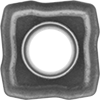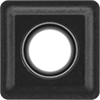Filter by
Drill Bits
Cut holes in a variety of metals, from the softest aluminum to the hardest steel.
High-Speed Steel Extended Length
Spiral Flute Round Shank | Standard |
Drill through walls and thick workpieces with our longest high-speed steel bits. Their length is good for creating deep holes but makes them less rigid than other bits. As a result, they are more prone to wobbling or breaking, especially when drilling hard materials.
Black Oxide—The dark finish increases wear resistance and reduces friction to improve chip flow, so these bits can last 50% longer than uncoated bits.
Titanium Nitride (TiN) Coated—Drill at higher speeds and last longer than uncoated and oxide-coated bits, especially on tough materials like hardened steel and nickel.
Uncoated—The most economical option, uncoated bits perform best when used on low-carbon steel and aluminum. Polished to reduce friction, they're also known as bright finish bits.
Round Shank—The most common shank type. These fit in the chuck of drill presses and portable drills.
Standard Point—Good for general purpose drilling. You’ll need to make a pilot hole to center the bit.
Shank | |||||||||||||||||||||||||||||||||||||||||||||||||||||||||||||||||||||||||||||||||||||||||||||||||||
|---|---|---|---|---|---|---|---|---|---|---|---|---|---|---|---|---|---|---|---|---|---|---|---|---|---|---|---|---|---|---|---|---|---|---|---|---|---|---|---|---|---|---|---|---|---|---|---|---|---|---|---|---|---|---|---|---|---|---|---|---|---|---|---|---|---|---|---|---|---|---|---|---|---|---|---|---|---|---|---|---|---|---|---|---|---|---|---|---|---|---|---|---|---|---|---|---|---|---|---|
Drill Bit Size | Decimal Size Equiv. | Overall Lg. | Max. Drilling Dp. | Flute Type | Type | Size | Drill Bit Point Type | No. of Flutes | Each | ||||||||||||||||||||||||||||||||||||||||||||||||||||||||||||||||||||||||||||||||||||||||||
Black Oxide | |||||||||||||||||||||||||||||||||||||||||||||||||||||||||||||||||||||||||||||||||||||||||||||||||||
Inch | |||||||||||||||||||||||||||||||||||||||||||||||||||||||||||||||||||||||||||||||||||||||||||||||||||
| 21/64" | 0.3281" | 6 1/2" | 3.63" | Spiral | Round | 21/64" | Standard | 2 | 000000000 | 000000 | |||||||||||||||||||||||||||||||||||||||||||||||||||||||||||||||||||||||||||||||||||||||||
| 11/32" | 0.3438" | 6 1/2" | 3.6" | Spiral | Round | 11/32" | Standard | 2 | 000000000 | 00000 | |||||||||||||||||||||||||||||||||||||||||||||||||||||||||||||||||||||||||||||||||||||||||
Letter Size | |||||||||||||||||||||||||||||||||||||||||||||||||||||||||||||||||||||||||||||||||||||||||||||||||||
| O | 0.316" | 6 1/2" | 3.65" | Spiral | Round | 0.316" | Standard | 2 | 0000000 | 00000 | |||||||||||||||||||||||||||||||||||||||||||||||||||||||||||||||||||||||||||||||||||||||||
| P | 0.323" | 6 1/2" | 3.64" | Spiral | Round | 0.323" | Standard | 2 | 0000000 | 00000 | |||||||||||||||||||||||||||||||||||||||||||||||||||||||||||||||||||||||||||||||||||||||||
| Q | 0.332" | 6 1/2" | 3.62" | Spiral | Round | 0.332" | Standard | 2 | 0000000 | 00000 | |||||||||||||||||||||||||||||||||||||||||||||||||||||||||||||||||||||||||||||||||||||||||
| R | 0.339" | 6 1/2" | 3.61" | Spiral | Round | 0.339" | Standard | 2 | 0000000 | 00000 | |||||||||||||||||||||||||||||||||||||||||||||||||||||||||||||||||||||||||||||||||||||||||
Titanium Nitride (TiN) Coated | |||||||||||||||||||||||||||||||||||||||||||||||||||||||||||||||||||||||||||||||||||||||||||||||||||
Inch | |||||||||||||||||||||||||||||||||||||||||||||||||||||||||||||||||||||||||||||||||||||||||||||||||||
| 21/64" | 0.3281" | 6 1/2" | 4.13" | Spiral | Round | 21/64" | Standard | 2 | 000000000 | 00000 | |||||||||||||||||||||||||||||||||||||||||||||||||||||||||||||||||||||||||||||||||||||||||
| 11/32" | 0.3438" | 6 1/2" | 4.13" | Spiral | Round | 11/32" | Standard | 2 | 000000000 | 00000 | |||||||||||||||||||||||||||||||||||||||||||||||||||||||||||||||||||||||||||||||||||||||||
Letter Size | |||||||||||||||||||||||||||||||||||||||||||||||||||||||||||||||||||||||||||||||||||||||||||||||||||
| Q | 0.332" | 6 1/2" | 4.13" | Spiral | Round | 0.332" | Standard | 2 | 000000000 | 00000 | |||||||||||||||||||||||||||||||||||||||||||||||||||||||||||||||||||||||||||||||||||||||||
Uncoated | |||||||||||||||||||||||||||||||||||||||||||||||||||||||||||||||||||||||||||||||||||||||||||||||||||
Inch | |||||||||||||||||||||||||||||||||||||||||||||||||||||||||||||||||||||||||||||||||||||||||||||||||||
| 21/64" | 0.3281" | 6 1/2" | 4.13" | Spiral | Round | 21/64" | Standard | 2 | 0000000 | 00000 | |||||||||||||||||||||||||||||||||||||||||||||||||||||||||||||||||||||||||||||||||||||||||
| 11/32" | 0.3438" | 6 1/2" | 4.13" | Spiral | Round | 11/32" | Standard | 2 | 0000000 | 00000 | |||||||||||||||||||||||||||||||||||||||||||||||||||||||||||||||||||||||||||||||||||||||||
Cobalt Steel Jobbers' Length
Morse Taper Shank |
Split |
The toughness and wear resistance of cobalt steel in a length that's rigid enough for most applications. Cobalt lasts at least twice as long as high-speed steel. It can also run up to 25% faster at higher temperatures without damaging the bit on hard materials such as nickel.
Uncoated—Polished to eject chips, these are also known as bright finish bits.
Morse Taper Shank—Insert directly into the tapered spindle on machines such as drill presses and lathes.
Split Point—Starts cutting on contact so you don’t need a pilot hole. The point also keeps the bit centered for straight and accurate holes, even with a portable drill.
Cobalt Steel Extended Length
Spiral Flute Round Shank |
Split |
Drill through walls and thick workpieces and make deep holes with the longest bits made of tough and wear-resistant cobalt. They last at least twice as long as high-speed steel and can run up to 25% faster and at higher temperatures without damaging the bit or material. The length makes them less rigid than other bits, however, so they are more prone to wobbling or breaking, especially when drilling hard materials.
Uncoated—Polished to eject chips, these are also known as bright finish bits.
Round Shank—The most common shank type. These fit in the chuck of drill presses and portable drills.
Split Point—Starts cutting on contact so you don’t need a pilot hole. The point also keeps the bit centered for straight and accurate holes, even with a portable drill.
Carbide-Tipped Steel Extended Length
Spiral Flute Round Shank |
Standard |
Drill through walls and thick workpieces and make deep holes with bits that offer the performance of solid carbide but at a lower price point. Like carbide bits, these are stronger than cobalt and high-speed steel to maintain their sharp edges when drilling abrasive material. However, when drilling tough metals like cast iron and hardened steel, upgrade to carbide for longer life. Because of their length, these aren't as rigid as other bits and more prone to wobbling.
Round Shank—The most common shank type. These fit in the chuck of drill presses and portable drills.
Standard Point—Good for general purpose drilling. You’ll need to make a pilot hole to center the bit.
Shank | |||||||||||||||||||||||||||||||||||||||||||||||||||||||||||||||||||||||||||||||||||||||||||||||||||
|---|---|---|---|---|---|---|---|---|---|---|---|---|---|---|---|---|---|---|---|---|---|---|---|---|---|---|---|---|---|---|---|---|---|---|---|---|---|---|---|---|---|---|---|---|---|---|---|---|---|---|---|---|---|---|---|---|---|---|---|---|---|---|---|---|---|---|---|---|---|---|---|---|---|---|---|---|---|---|---|---|---|---|---|---|---|---|---|---|---|---|---|---|---|---|---|---|---|---|---|
Drill Bit Size | Decimal Size Equiv. | Overall Lg. | Max. Drilling Dp. | Flute Type | Type | Size | Drill Bit Point Type | No. of Flutes | Each | ||||||||||||||||||||||||||||||||||||||||||||||||||||||||||||||||||||||||||||||||||||||||||
Uncoated Carbide Tipped | |||||||||||||||||||||||||||||||||||||||||||||||||||||||||||||||||||||||||||||||||||||||||||||||||||
Inch | |||||||||||||||||||||||||||||||||||||||||||||||||||||||||||||||||||||||||||||||||||||||||||||||||||
| 11/32" | 0.3438" | 6 1/2" | 3.44" | Spiral | Round | 11/32" | Standard | 2 | 00000000 | 000000 | |||||||||||||||||||||||||||||||||||||||||||||||||||||||||||||||||||||||||||||||||||||||||
Carbide-Insert Drill Bits
When you need to drill dozens or even hundreds of holes, use a bit with replaceable carbide inserts. Once the cutting edges wear down, just change the inserts instead of sharpening or throwing the bit away. The holes in the bit channel coolant through the tool for more efficient chip evacuation. Each drill bit requires two inserts—one on the inner cutting edge and one on the outer cutting edge. Replacement inserts are sold separately.
Steel
 |  | |
Spiral Flute Round Shank | Inner Drill Bit Inserts | Outer Drill Bit Inserts |
Round Shank—The most common shank type. These fit in the chuck of drill presses and portable drills.
Shank | For Insert | Inner Drill Bit Inserts | Outer Drill Bit Inserts | Replacement Screws | |||||||||||||||||||||||||||||||||||||||||||||||||||||||||||||||||||||||||||||||||||||||||||||||
|---|---|---|---|---|---|---|---|---|---|---|---|---|---|---|---|---|---|---|---|---|---|---|---|---|---|---|---|---|---|---|---|---|---|---|---|---|---|---|---|---|---|---|---|---|---|---|---|---|---|---|---|---|---|---|---|---|---|---|---|---|---|---|---|---|---|---|---|---|---|---|---|---|---|---|---|---|---|---|---|---|---|---|---|---|---|---|---|---|---|---|---|---|---|---|---|---|---|---|---|
Drill Bit Size | Decimal Size Equiv. | Overall Lg. | Max. Drilling Dp. | Flute Type | Type | Size | Drill Bit Point Type | No. of Flutes | Inner Inscribed Circle Dia. | Outer Inscribed Circle Dia. | Each | Each | Each | Each | |||||||||||||||||||||||||||||||||||||||||||||||||||||||||||||||||||||||||||||||||||||
Inch | |||||||||||||||||||||||||||||||||||||||||||||||||||||||||||||||||||||||||||||||||||||||||||||||||||
| 3/4" | 0.75" | 6 1/2" | 2 1/4" | Spiral | Round | 1" | Carbide Insert | 2 | 0.224" | 0.236" | 0000000 | 0000000 | 0000000 | 000000 | 0000000 | 000000 | 0000000 | 00000 | |||||||||||||||||||||||||||||||||||||||||||||||||||||||||||||||||||||||||||||||||
Tapping Screw Installation Drill Bits for Masonry and Concrete
Create an undersized hole so concrete tapping screws fit tightly once they're threaded into place. These bits are slightly smaller than the matching screw size. They have a carbide tip that resists wear and heat to stay sharp.
Round Shank for Hammer and Rotary Drilling
Use these bits in rotary hammers that have a drill chuck. Simultaneous rotary and hammering action drills faster and penetrates material with less pressure than rotary-only bits. Also known as percussion or impact bits.
Standard Point—The most common point type handles most jobs. However, for more aggressive cutting that generates a lot of heat, consider a multipoint or serrated bit.
For Screw Size | Drill Bit Size | Decimal Size Equiv. | Overall Lg. | Max. Drilling Dp. | Shank Size | No. of Flutes | Flute Type | Features | Each | ||||||||||||||||||||||||||||||||||||||||||||||||||||||||||||||||||||||||||||||||||||||||||
|---|---|---|---|---|---|---|---|---|---|---|---|---|---|---|---|---|---|---|---|---|---|---|---|---|---|---|---|---|---|---|---|---|---|---|---|---|---|---|---|---|---|---|---|---|---|---|---|---|---|---|---|---|---|---|---|---|---|---|---|---|---|---|---|---|---|---|---|---|---|---|---|---|---|---|---|---|---|---|---|---|---|---|---|---|---|---|---|---|---|---|---|---|---|---|---|---|---|---|---|
Uncoated Carbide-Tipped Steel | |||||||||||||||||||||||||||||||||||||||||||||||||||||||||||||||||||||||||||||||||||||||||||||||||||
Standard Point | |||||||||||||||||||||||||||||||||||||||||||||||||||||||||||||||||||||||||||||||||||||||||||||||||||
| 1/4" | 3/16" | 0.1875" | 6 1/2" | 5" | 5/32" | 2 | Open | Flat on Shank | 000000000 | 00000 | |||||||||||||||||||||||||||||||||||||||||||||||||||||||||||||||||||||||||||||||||||||||||
Adjustable-Blade Drill Bits for Wood
Bore a variety of hole sizes with one bit—just slide the blade to the desired diameter and then tighten the screw. These have two sharp edges for faster cuts than fluted bits and won't cause the surface of the material to splinter. A centering point keeps them stable while drilling soft and hard woods such as pine, plywood, and oak. Like standard flat-blade bits, these drill rough holes for wire and pipe but should be used in a drill press rather than a hand-held tool. Also known as spade bits.
Round Shank—Fit in the chuck of drill presses and portable drills.
Drill Bit Size | Decimal Size Equiv. | Decimal Size Equiv. Range | Overall Lg. | Shank Size | Drill Bit Point Type | Each | |||||||||||||||||||||||||||||||||||||||||||||||||||||||||||||||||||||||||||||||||||||||||||||
|---|---|---|---|---|---|---|---|---|---|---|---|---|---|---|---|---|---|---|---|---|---|---|---|---|---|---|---|---|---|---|---|---|---|---|---|---|---|---|---|---|---|---|---|---|---|---|---|---|---|---|---|---|---|---|---|---|---|---|---|---|---|---|---|---|---|---|---|---|---|---|---|---|---|---|---|---|---|---|---|---|---|---|---|---|---|---|---|---|---|---|---|---|---|---|---|---|---|---|---|
Uncoated Steel | |||||||||||||||||||||||||||||||||||||||||||||||||||||||||||||||||||||||||||||||||||||||||||||||||||
Round Shank | |||||||||||||||||||||||||||||||||||||||||||||||||||||||||||||||||||||||||||||||||||||||||||||||||||
| 7/8" to 3" | 0.875" to 3" | 0.875" to 3" | 6 1/2" | 11/32" | Standard | 0000000 | 000000 | ||||||||||||||||||||||||||||||||||||||||||||||||||||||||||||||||||||||||||||||||||||||||||||
Chip-Clearing Drill Bits for Wood
Quick-Change Hex Shank |
Prevent clogs that wear the bit and slow down drilling when it gets jammed. The flutes on these bits have an open design that pulls chips out of the hole faster than standard spiral flutes. Also known as pole or ship auger bits, they are used to cut deep holes through lumber, railroad ties, and utility poles.
Quick-Change Hex Shank—Switch bits instead of tools. These simplify jobs by snapping directly into power screwdrivers, drills, and other tools that accept a 1/4" hex shank.
Screw Point—Draws the bit into the material without the need to apply a lot of pressure.

























